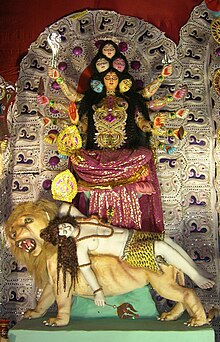P.J.
0
Adi Sakthi Peetha -Guwahati-Assam-Yoni Kanda- Kamakshya
Kamakhya Temple:

Kamakhya is pictured as a young goddess, 16 years old, with twelve arms and six heads of varying colors, representing a powerful goddess who is omnipotent, omniscient and omnipresent. She is ornately dressed, typically wearing a red sari, opulent jewelry and red flowers such as hibiscus.
She holds in each of ten hands a lotus, trident, sword, bell, discus, bow, arrows, club or scepter, goad, and shield. Her remaining two hands hold a bowl, which is made either of gold or a skull.
She is seated upon a lotus, which emerges from the navel of the corpse of Shiva, who in turn lies atop a lion.
To each side of her sit Brahma and Vishnu, who are each seated upon a lotus, as well.
The Kamakhya Temple is a Shakti Peeth temple situated on the Nilachal Hill in western part of Guwahati city in Assam, India. It is the main temple in a complex of individual temples dedicated to different forms of the mother goddess as the Dasa Mahavidya, including Bhuvaneshvari, Bagalamukhi, Chinnamasta, Tripura Sundari and Tara. It is an important pilgrimage destination for general Hindu and Tantric worshipers.
History:
The temple was built in first millennium during the time of Kamarupa. Allahabad rock inscriptions of Samudragupta mentioned about it. Temple was destroyed during the middle of second millennium and revised temple structure was constructed in 1565 by Chilarai of the Koch dynasty in the style of medieval temples. The current structure has a beehive-like shikhara with delightful sculptured panels and images of Ganesha and other Hindu gods and goddesses on the outside .
The temple consists of three major chambers. The western chamber is large and rectangular and is not used by the general pilgrims for worship. The middle chamber is a square, with a small idol of the Goddess, a later addition. The walls of this chamber contain sculpted images of Naranarayana, related inscriptions and other gods.
 The middle chamber leads to the sanctum sanctorum of the temple in the form of a cave, which consists of no image but a natural underground spring that flows through a yoni-shaped cleft in the bedrock.
The middle chamber leads to the sanctum sanctorum of the temple in the form of a cave, which consists of no image but a natural underground spring that flows through a yoni-shaped cleft in the bedrock.
During the Ambuvaci festival each summer, the menstruation of the Goddess Kamakhya is celebrated. During this time, the water in the main shrine runs red with iron oxide resembling menstrual fluid.
It is likely that this is an ancient Khasi sacrificial site, and worshiping here still includes sacrifices. Devotees come every morning with goats to offer to Shakti. The Kalika Purana, an ancient work in Sanskrit describes Kamakhya as the yielder of all desires, the young bride of Shiva, and the giver of salvation.Shakti is known as Kamakhya.
Shakti Peethas
Kamakhya - Wikipedia, the free encyclopedia
Kamakhya Temple:

Kamakhya is pictured as a young goddess, 16 years old, with twelve arms and six heads of varying colors, representing a powerful goddess who is omnipotent, omniscient and omnipresent. She is ornately dressed, typically wearing a red sari, opulent jewelry and red flowers such as hibiscus.
She holds in each of ten hands a lotus, trident, sword, bell, discus, bow, arrows, club or scepter, goad, and shield. Her remaining two hands hold a bowl, which is made either of gold or a skull.
She is seated upon a lotus, which emerges from the navel of the corpse of Shiva, who in turn lies atop a lion.
To each side of her sit Brahma and Vishnu, who are each seated upon a lotus, as well.
The Kamakhya Temple is a Shakti Peeth temple situated on the Nilachal Hill in western part of Guwahati city in Assam, India. It is the main temple in a complex of individual temples dedicated to different forms of the mother goddess as the Dasa Mahavidya, including Bhuvaneshvari, Bagalamukhi, Chinnamasta, Tripura Sundari and Tara. It is an important pilgrimage destination for general Hindu and Tantric worshipers.
History:
The temple was built in first millennium during the time of Kamarupa. Allahabad rock inscriptions of Samudragupta mentioned about it. Temple was destroyed during the middle of second millennium and revised temple structure was constructed in 1565 by Chilarai of the Koch dynasty in the style of medieval temples. The current structure has a beehive-like shikhara with delightful sculptured panels and images of Ganesha and other Hindu gods and goddesses on the outside .
The temple consists of three major chambers. The western chamber is large and rectangular and is not used by the general pilgrims for worship. The middle chamber is a square, with a small idol of the Goddess, a later addition. The walls of this chamber contain sculpted images of Naranarayana, related inscriptions and other gods.

During the Ambuvaci festival each summer, the menstruation of the Goddess Kamakhya is celebrated. During this time, the water in the main shrine runs red with iron oxide resembling menstrual fluid.
It is likely that this is an ancient Khasi sacrificial site, and worshiping here still includes sacrifices. Devotees come every morning with goats to offer to Shakti. The Kalika Purana, an ancient work in Sanskrit describes Kamakhya as the yielder of all desires, the young bride of Shiva, and the giver of salvation.Shakti is known as Kamakhya.
Shakti Peethas
Kamakhya - Wikipedia, the free encyclopedia
